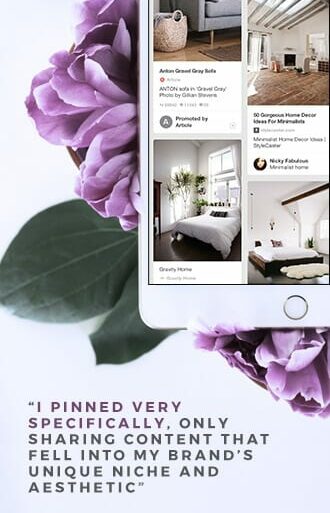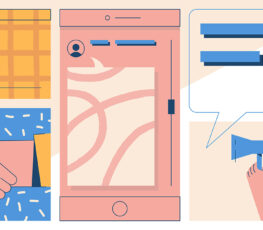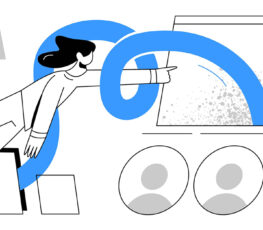Up until this last Spring, I never valued Pinterest as a legitimate marketing tool. It pains me to think that I solely viewed the platform as a place to save down DIYs that I’d never find the time to do (hey, cool cactus wall hangers!) or recipes that were far too complex for my skill-set (what’s a ‘gastrique’ anyway?).
It wasn’t until I began ramping up my blog content and regularly pinning it to Pinterest that I started to notice an uptick in my site traffic. I’m a big analytics nerd and love to analyze my traffic referrers in my analytics dashboard, so it’s safe to say that I was surprised to see that Pinterest was the third-best driver of traffic to my site.
After unearthing that little metric nugget I was a woman on a mission. I was instantly pinspired to grow my Pinterest presence organically and authentically, one pin at a time. Over the last 4 months I’ve doubled my Pinterest audience size and engagements rates, with the platform driving more traffic back to my blog than ever before.
Here’s how I doubled my pinterest following + drove more traffic to my website in just four months:
I pinned consistently.
It’s a no-brainer that adhering to a consistent pinning schedule helped bulk up my Pinterest boards and kept my re-pins consistently in front of my audience. I made a point to pin at least five pieces of content five days a week, making for at least 25 weekly pins on my account. On weeks that I had a lot of blog content rolling out this number would be higher, as I made a point to pin all content from my site.
I pinned on-brand content.
I also pinned very specifically, only sharing content that fell into my personal brand’s unique niche and aesthetic. My blog is career and lifestyle focused, so my audience expects content across all of my social channels that reflects such. On any given day I was pinning career wisdom, interviews with women entrepreneurs, home inspiration and lifestyle know-how, not cookie recipes, hairstyles I wanted to try or cute puppies.
As much as I love all of those things (especially puppies), they simply didn’t fit into my niche. When you hone in on your niche, your audience will come because they know what content to expect. My advice: when it comes to your audience, don’t keep them guessing! When you’ve found your niche, it’s a good thing to be predictable.
I updated the cover photos to be on-brand.
One last thing to consider is how your boards will cohesively mesh together for someone who visits your Pinterest profile for the first time. Will they all tell the same story, or will each look out of place and different from the other? In my case, I’ve made a point to keep my Pinterest board covers very uniform with light, airy and eye-catching photos that mirror my brand. It took all of 10 minutes to update each cover photo and helped my profile immensely in terms of consistency and aesthetics. Let’s face it: your audience expects your Pinterest to be pretty, inside and out.
I gave my boards SEO-friendly names.
When I first hopped on the Pinterest bandwagon, I had a thing for coming up with catchy titles for my boards: “Let’s Design Things,” for my graphic design board, “#BossBabe” for an entrepreneurial board – the list goes on and on. As much fun as it was coming up with those catchy board titles, the problem lies in the fact that big search engines like Google don’t care about cutesy verbiage – search engines just want to get to the facts and keywords they need to yield an accurate search.
I then learned that my Pinterest profile needed a SEO-friendly overhaul! I reluctantly pulled my fun titles and replaced them with more straightforward, descriptive and specific titles like, “The Entrepreneur,” “Minimalist Chic Wedding,” “Minimalist Home” and more. In addition, I added concise descriptions to each board like, “This is a board with home décor for the minimalist, featuring bedroom, kitchen and living room inspiration.” These descriptors all help amp up your SEO factor, especially when you use descriptive and concise keywords.
Within a month of overhauling my Pinterest board titles and descriptions, my Pinterest engagement stats began to pick up even more. Note that these changes were not noticeable by my audience and I definitely didn’t send out a tweet announcing, “Hey, just changed all of my Pinterest board titles and descriptions – better check “em out!” The traffic came simply due to a cleaner set of keywords being used to pull my profile into more Pinterest and search engine search results.
I used vertical images for my blog posts.
I used to have a huge hang-up against using vertical images in my blog posts. In my opinion, they were too long and threw the proportions off in the post. I loved short, horizontal images so dearly. However, vertical content rocks it on Pinterest due to the fact that it stands out more in the homepage feed and is much more eye-catching and pin-able than square or horizontal content.
With this in mind, I set out to test vertical creative in my blog content headers and body images. By using content to grow my personal brand on Pinterest, my content was receiving more re-pins than ever before, simply because my pins from my site were much more eye-catching and engaging.
Now, I shoot all blog photography vertical – no exceptions. When I make infographics to accompany my blogs, you better bet that they’re all vertical and as long as I can possibly make them.
I made infographics as long as possible.
When I post new printables to the design portal on my site, I create long, pin-worthy graphics solely to promote them on Pinterest. Is keeping Pinterest in mind while crafting content more time consuming? Yes. But is it entirely worth it? Yes! Bloggers and brands are rocking it on Pinterest with vertical content, and there’s no looking back at the horizontal content that blends into the homepage feed.
When it comes to Pinterest, learning how to grow your brand’s presence and influence takes time – just like any social platform. Remember that keeping pins visually inspiring, crafting SEO-friendly titles and copy and adhering to a pinning schedule will set you up your brand and Pinterest profile to be a lot more pinteresting!
[ca-sidebar id=5537]
















